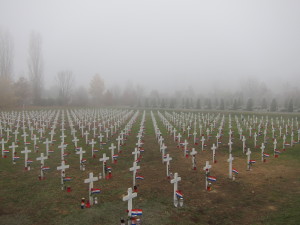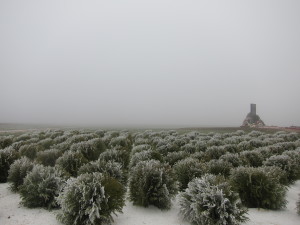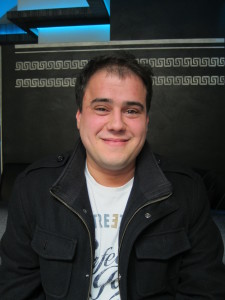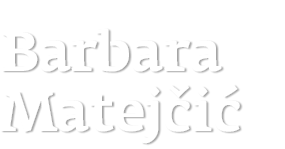Two decades after a Serbian siege almost reduced the town to rubble, Vukovar is an unsettled place, home to two communities that face separate ways.
By Barbara Matejcic from Vukovar
Croatian version
“Does this train strike you as one taking you to a nice place?” So asks my only fellow passenger in the only carriage of an old “Swede”, travelling from Vinkovci to Vukovar.
The train is called a Swede because it was built in Sweden in the early Eighties and, once it finished service there, came to Croatia in the Nineties. This line in the far east of Croatia is probably its last stop before retirement.
The seats are loose and worn out, and it isn’t exactly comfortable. The windows look like as if they haven’t been opened since they overlooked a Swedish landscape. There is no need for that this December morning. It is cold outside and the fog has fallen down low on the Slavonian plain.
“In Vukovar you have to wander the streets with a lantern searching for a gentle soul – for people not hardened by hatred and grief,” he says.
“People still look at one another as if they’re taking aim. You only want to get on the train and leave, not arrive,” my fellow passenger adds bitterly.
So, how are things in Vukovar 20 years after the town fell to Serbian forces and 14 years after its peaceful reintegration into Croatia – an event that finally marked the end of the war in Croatia and enabled the town’s exiled Croats to return home?

An hour after my arrival a local politician interrupted my first scheduled interview to spend an hour explaining the situation, particularly multiethnic relations. I started thinking that my fellow-passenger had been right. I felt like taking the first Swede back out of Vukovar. If there’s a voice that’s heard loud and clear in the town, it’s the voice of politicians. Two days later, after meeting dozen other people, it turned out that his soul had been the least gentle of all.
“Reconciliation doesn’t suit the nationalists in the local government. They live on ethnic divisions and dictate what is socially acceptable,” Srdjan Antic, of the Nansen Dialogue Centre, told me.
“Everything would be better if people didn’t behave as Serbs and Croats but as people and just listened to one another,” he adds.
Antic was born in Vukovar but lives in the nearby city of Osijek. He didn’t want his child to grow up in a divided environment. When his wife was about to give birth in a local hospital, a nurse asked what nationality the child would be.
Located right on the border with Serbia, before the war and the break-up of Yugoslavia Vukovar was an important industrial and cultural centre of Slavonien region. Because of the big plants that operated in the town, workers moved here from all over Yugoslavia. With 23 different nationalities, it became an ethnic melting pot in which there few people went without jobs.
But in 1991, after Croatia declared independence, the town was encircled by the Yugoslav People’s Army and allied Serb paramilitaries. Some 7,000 missiles fell daily on the town throughout the three-month siege, destroying about 85 per cent of the buildings.
Over 3,000 people were killed, and, after the town fell on November 18, 1991, 22,000 non-Serbs were expelled. Vukovar was the first town in Europe to be destroyed by war since the end of World War II.
Vukovar is embedded in Croatia’s collective memory as a symbol of suffering and pain. Everyone in Croatia has a mental vision of Vukovar, even those who weren’t even born at the time of the war: lines of refugees; children crying; a bombed hospital; razed buildings.
Following the Erdut peace agreement between Croatian and Serbia, which sometimes has been described as the UN’s most successful peace mission in the world, Croats began returning to the town, which from November 1991 to 1998 was almost exclusively populated by Serbs.
According to the 2001 population census, Vukovar has a population of 31,670, of whom 57.46 per cent are Croats and 32.88 per cent Serbs. Before the 1991 war, Vukovar had a population of 44,639 of whom 47.2 per cent were Croatian and 32.3 per cent Serbian.
Mayor Zeljko Sabo describes Vukovar today as a town of peace and tolerance. But many will say it’s peaceful only according to a police statistics, and tolerant only in the sense that Croats and Serbs put up with each other because they have no choice.
Although Vukovar has been rebuilt to a great extent, at first glance any passer-by can see that something terrible took place in these streets. Buildings hit by shelling, some with bullet holes pock-marking the brickwork, stand in the town centre. Most residents say they no longer notice the ruins but they certainly feel the divisions.

“If looks could kill there would be many dead people every day in Vukovar. It is still a divided place”
“If looks could kill there would be many dead people every day in Vukovar. It is still a divided place,” Ljiljana Gehrecke says.
We are talking in the modest office of the Europe House civil association that she has headed in Vukovar since 2000. Gehrecke says she feels particularly sorry for the young people who are burdened by the past for which they bear no responsibility.
These young people, she says, attend separate schools and have little contact. All that unites them is a desire to leave. Recalling her experience of a workshop with high-school graduates, she notes that when she asked them what they wanted to achieve in life they couldn’t come up with anything. The first to speak up said he wished to leave Vukovar and go as far away as possible as soon as he finished school. All the others immediately agreed.
“They want an environment that offers a normal life rather than a sad past. Here they have a feeling that they need to weep all the time over something,” Gehrecke says.
Her words reminded me of a letter sent by a reader to a local newspaper. The reader’s son had been killed in Vukovar and she had every reason to feel sad.
But she complained that even on New Year’s Eve at midnight it was organized the lighting of candles at the Memorial Cross in the town centre to honour the victims of war. At a time when the whole world is rejoicing we can’t be joyful even for that one evening, she protested.
“Vukovar has moderately severe depression, but it could be cured if existential perspectives existed,” Dr Nikola Drobnjak, former chief of Vukovar General Hospital psychiatric ward, told me.
Drobnjak comes from nearby Vinkovci and before the war often went out in Vukovar in the evenings. He has worked there for many years since the war.
“Vukovar before and after the war cannot be compared, it’s a completely different town. Everyone is traumatized here, even the children,” he says.
“At the time of the anniversary of the fall of Vukovar, the pressure on psychiatric institutions grows because people are again reminded of the war and of all they went through,” he notes.
“They then spend the next 11 months trying to break free from the past and restore their lives to normality – until the next anniversary. They are in a circle that they can’t break. People here are still waging their internal wars,” he adds.
Drobnjak believes more employment would be one way to kick-start the town’s delayed recovery.
“Enough monuments have been put up in Vukovar. Let the next monument to the town be a new factory,” he says.
But factories are closing in Vukovar, not opening. Unemployment is above the Croatian average 17.9 per cent and many locals say the lack of jobs, not multiethnic relations, is the main problem.
Like many others, Gehrecke agrees that Vukovar is stuck in the past. What she doesn’t agree with is that improved economic conditions alone offer the key to a solution.
“It wouldn’t benefit Vukovar to be treated as an unfortunate poor place that needs constant assistance, as if the whole world owes it something because of its sacrifice,” she maintains.
“What we need more than anything is a signal that life will go on. I believe we all have a smouldering desire for mental relief, but that we don’t know how to overcome our negative emotions.
Almost nothing is being done about this. Even if all the Serbs or Croats left the town, the hatred would stay behind,” she concludes.
I had last met Gehrecke in November 2011 at an event marking the 20th anniversary of the fall of Vukovar. 50,000 people from all over Croatia assembled on November 18 for a Walk of Memory through the town.
A day later a small commemoration service was held in the courtyard of the then Velepromet Serb camp. The Croatian Association of Camp Inmates of Serbian Concentration Camps, HDLSKL, says some 10,000 fighters and civilians who defended the town passed through this camp after the town fell.
One of the speeches delivered on that cold November day was that by Brother Vjenceslav Janjic. He spoke in a conciliatory manner, stressing that without a dialogue there can be no reconciliation or truth, and that without truth myths are created from which new conflicts proceed.
I ask Gehrecke how come the rhetoric had changed for the better, on the important 20th anniversary of the town’s fall, when a great deal of national pathos might have been expected in speeches? “Time has done its work. Nothing else,” she says.
Srdjan Antic says no well-thought-out program for dealing with the trauma of the war has been conducted in Vukovar, and that the good work mostly boils down to ad hoc activities by non-governmental associations.
“All the positive changes in Vukovar, and there have only been a few of them, are not a result of institutions and of the political leadership’s long-term programs; it’s just the passage of time and the fact that people are forced to live together,” Antic says.
One of the concrete causes of the continuing deep divisions in the town is schooling. Ever since the reintegration programme was drawn up in the late Nineties, Croat and Serb children in Vukovar have attended separate schools and kindergartens. Whoever you ask agrees this is wrong. But the Serbs have a legal right to schooling in their language and Cyrillic script.
“This institutionalised segregation predetermines both the life and the attitude of children in Vukovar,” Antic says. “Starting at kindergarten, children enter a ghetto and have no contact with those in the other ghetto; there is no interaction outside the institutions in spite of everything the politicians say,” Antic says.
“The result is that young people are convinced that joint life is impossible,” Antic adds.
The Nansen Dialogue Centre, an NGO Antic works for, in 2000 launched a project entitled New School, which would be open to all those who don’t want to separate their children. They have verified the program and have more than enough interested parents and teachers, but no one knows when the school will actually start because they have received no support from local politicians.
“We want this to be a state school, not a private one, because this would prove that Vukovar is ready for change. But this obviously still isn’t the case because the competent institutions don’t want to begin setting up this school,” he said.
Researches conducted in Vukovar by psychologists Dinka Corkalo Biruski and Dean Ajdukovic demonstrates the impact of separate schools on children.
Children are less prepared to establish contacts with members of the other ethnic group than their parents, the study concluded.
Even though they never personally experienced the war, unlike their parents, the children have never experienced life in an undivided society. As far as they are concerned, division is the natural state of affairs.
Other research has also shown that most Croats and Serbs believe dividing children at school hinders the establishment of better relations in Vukovar. Nevertheless, every school year they enrol their children in separate classes. “Those who break the unwritten rules of the group come under great pressure from society,” says Antic.

Maja Tanasić and Jelena Stajin: “Things cannot improve in Vukovar as long as children are separated from the youngest age and for as long as hatred is passed down from generation to generation”
Maja Tanasic and Jelena Stajin are both 16 and attend high school in Serbian. Classes in Croatian are held in the same building. All students spend their every recess outside the school, but the two groups avoid each other, standing in “their” parts of the courtyard. Maja and Jelena don’t have any Croat friends.
On a Saturday morning we meet in a downtown café patronised by Serbs, they told me. That evening they will go out to places where only fellow-Serbs hang out. They don’t meet their Croat peers.
For Maja and Jelena “bygones are bygones”, the war is a thing of the past and they’re not interested in the topic.
On the anniversaries of the fall of Vukovar they stay at home, like most of their fellow Serbs. They have no special opinion about what happened in Vukovar. They do think about the future, however, away from Vukovar.
“Things cannot improve in Vukovar as long as children are separated from the youngest age and for as long as hatred is passed down from generation to generation,” Maja says.
When they finish high school they will both continue higher education most probably in Serbia, as many young Serbs from Vukovar already did. This will present no problems. They speak Serbian, their documents are in Cyrillic, and, as members of the Serbian diaspora, they have priority when enrolling in Serbian faculties. Antic describes this as a “democratic” form of ethnic cleansing.
It is hard to establish how many young people leave Vukovar each year never to return. Official institutions have no information. Many Croats in Vukovar say that Serbs who don’t want their children to leave Croatia usually send their children to Croatian schools.
One such person is Mile Ivkovic. His view of Vukovar is a more optimistic, perhaps because he only moved here after the conflict in 1999. His wife is from the town. However, the war did not bypass him. When the war broke out in his hometown of Sisak, he took up arms, was wounded and so has official status as a Croatian veteran.
None of this is unusual – except that Mile is an ethnic Serb. His is not a unique example. About 6 per cent of the men who defended Vukovar from Serbian forces were Serbs themselves. He socialises with all sides, celebrating both the Catholic and Orthodox Christmas.

Stanko Zadro: “We fought against Serbian politics, not against Serbian citizens”
“There’s no need to slur an entire people with everything that happened. We fought against Serbian politics, not against Serbian citizens,” Stanko Zadro says.
We met at the launch of a book dedicated to his brother, Blago Zadro, who has become a symbol of the defence of Vukovar. Streets and schools in Croatia have been named after him.
Blago Zadro and his son Robert were killed in the war. After Vukovar fell, Stanko and his father were captured and taken to camps in Serbia. But Stanko feels no hatred for the former enemy.
“Those who want to live here have to accept the reality that Vukovar is a multiethnic environment,” he says.
He returned to Vukovar in 2001. What he found, he says, was a gloomy, muddy, half-demolished town. He says it is now improving, not just on the outside, because the tension has eased.
Judging by Interior Ministry statistics, this is so. Vukovar is not a crime-ridden environment. Last year, 3.5 times more crimes were reported in prosperous coastal Zadar than in Vukovar. Only seven hate crimes have been registered in Vukovar in the past five years. Police say these mainly involve graffiti, and are quickly removed.
How is it that there are so few inter-ethnic incidents in a town where almost everyone lost a loved one and where you often hear that war criminals are walks the streets unpunished?
The answers are diverse. At a hair salon in the town centre, whose customers, I’m told, include both sides – because at a time of economic the crisis the only important thing is the price – one customer says that incidents happen every week but the police hush things up. Another customer says that there are so many police officers in the streets that nothing can happen.

Zoran Pehar: “The whole truth must come out. There are still two different versions here of everything that happened, Croatian and Serb”
“At 3am I feel safer in the streets of Vukovar than on the streets of Zagreb,” journalist Zoran Pehar maintains.
As a child, in the summer of 1991 he travelled with his parents to the coast. The summer holiday ended but the war broke out so they could no longer go home. Four months ago he moved back to Vukovar when Nova TV sent him there as a correspondent.
Zoran is happy to be back. He has a job and friends. None are Serbian, but this is not because he wouldn’t want some, he says, but because he hasn’t met any. Zoran believes people in Vukovar will turn to the future only once they feel the past has received its proper epilogue.
“Everyone needs to know what happened to all the missing people we’ve been searching for for 20 years,” he says. “The whole truth must come out. There are still two different versions here of everything that happened, Croatian and Serb.”
Over the years, about 1,280 victims of the conflict in Vukovar have been identified in exhumations of mass and individual graves. Another 345 people from Vukovar remain missing and their relatives are still searching for them.
“The truth that suits the Croats wouldn’t maybe be the only thing to surface,” I respond, recalling that Serbs often say that before conflict started, Serbs went missing and their houses and shops were bombed and attacked.
“So let it,” Zoran replies. “Let us learn everything so we can finally put an end to it all.”
Before we part, out of curiosity I ask why we have met in a café mainly used by Serbs. It was the same café in which Maja and Jelena met me earlier that morning and they had told me that it was “Serbian”.
Zoran shrugs. He thought it was a “Croat” place. We ask the waiter who owns the place – not an unusual question in Vukovar. “The owners are a Croat and a Serb,” the waiter replies. Zoran and I laugh.
It’s a sunny day. I’m leaving Vukovar by Swed.
This article was produced as part of the Alumni Initiative of the Balkan Fellowship for Journalistic Excellence. Both are initiated and funded by the Robert Bosch Stiftung and the ERSTE Foundation.
